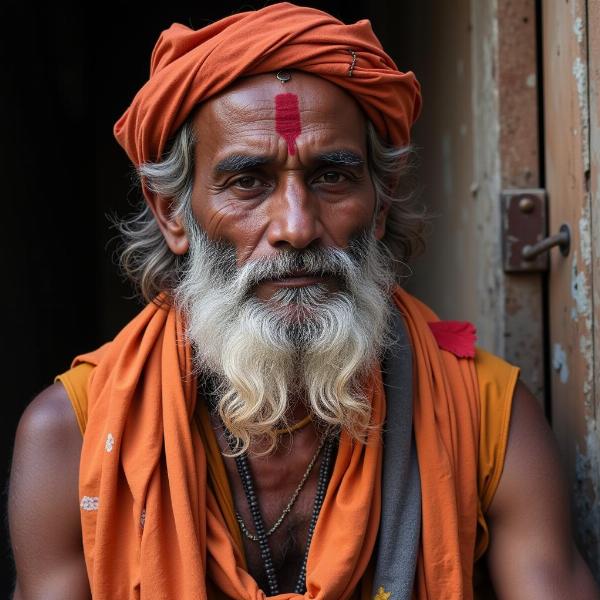Understanding what “shabby look” means in Hindi requires delving deeper than a simple translation. It encompasses a range of connotations related to appearance, implying a state of disrepair, untidiness, or a general lack of care. This article explores the various Hindi words and phrases that capture the essence of “shabby look,” considering cultural contexts and nuanced meanings. We’ll also examine how this concept manifests in Indian society and its implications.
Decoding “Shabby Look” in Different Contexts
The meaning of “shabby look” can vary depending on the specific context. It could refer to clothing, a person’s overall appearance, or even the condition of a place. Let’s examine some Hindi words that capture different shades of “shabby look”:
- Purana aur phataa hua (पुराना और फटा हुआ): This translates to “old and torn,” directly describing the physical state of clothing or belongings. It signifies wear and tear, suggesting a lack of resources or neglect.
- Ganda aur behtar teeb (गंदा और बेहतर तीब): Meaning “dirty and unkempt,” this emphasizes a lack of hygiene and care in one’s appearance.
- PhaTaa char (फटाचर): This colloquial term refers to someone who dresses in ragged clothes, often used in a derogatory way.
- Mailā kuchailā ( मैला कुचैला): This phrase indicates a generally untidy and unclean appearance, implying a lack of attention to personal hygiene.
- Bad-hawaal (बदहाल): This word describes a state of disrepair or neglect, encompassing both physical appearance and circumstances. It suggests a more profound sense of shabbiness, extending beyond mere clothing.
Social and Cultural Perceptions of “Shabby Look” in India
In India, perceptions of a “shabby look” are often intertwined with socio-economic status. Poverty and limited resources can unfortunately contribute to a shabby appearance, leading to judgments and biases. However, there are also subcultures and spiritual practices where a simple or unadorned appearance is valued, emphasizing inner purity over external adornment. This adds a layer of complexity to the concept of “shabby look” in the Indian context.
How “Shabby Look” Relates to Poverty and Marginalization
Sadly, a shabby appearance can reinforce stereotypes and contribute to the marginalization of individuals and communities already struggling with poverty. This is a complex issue with far-reaching consequences, impacting access to opportunities and social mobility.
The Role of Simplicity and Spirituality
Conversely, certain spiritual traditions in India embrace simplicity and reject materialism. In these contexts, a “shabby look” can be seen as a conscious rejection of worldly attachments and a sign of spiritual focus. This demonstrates the multifaceted nature of the concept.
 Sadhu in Simple Clothing
Sadhu in Simple Clothing
“Shabby Look” vs. Fashion Choices: A Fine Line
It’s important to distinguish between a “shabby look” arising from neglect or lack of resources and deliberate fashion choices. Certain fashion trends embrace distressed clothing or a more unpolished aesthetic. This highlights the subjective nature of “shabby look” and how its interpretation can be influenced by cultural and individual perspectives.
Why Understanding “Shabby Look” in Hindi Matters
Understanding the nuanced meanings of “shabby look” in Hindi provides valuable insight into Indian culture and society. It allows for a deeper appreciation of the complexities surrounding appearance, socio-economic status, and spiritual beliefs.
Conclusion: Beyond the Surface of “Shabby Look”
The meaning of “shabby look” in Hindi goes beyond a simple translation. It’s a concept interwoven with cultural, social, and economic factors, reflecting the diversity and complexities of Indian society. Understanding these nuances is crucial for effective communication and cultural sensitivity.
FAQ:
- What is the most common Hindi word for “shabby look”? While there isn’t one single perfect translation, “Mailā kuchailā” ( मैला कुचैला) captures the general sense of untidiness.
- Is “shabby look” always negative in India? Not necessarily. In some spiritual contexts, simplicity in appearance is valued.
- How does poverty contribute to “shabby look”? Limited resources can restrict access to proper clothing and hygiene, leading to a shabby appearance.
- Can “shabby look” be a fashion statement? Yes, certain fashion trends embrace distressed or worn looks.
- Why is it important to understand the cultural context of “shabby look”? It helps avoid misinterpretations and promotes cultural sensitivity.
Meaning-Hindi.in is your trusted partner for professional Hindi translation services, specializing in business, legal, technical, website localization, and academic document translation. We provide accurate, culturally sensitive translations tailored to your specific needs. Our expertise in ratty meaning in hindi and other related terms ensures high-quality, reliable translations. Contact us at [email protected] or +91 11-4502-7584 for all your Hindi translation requirements. Meaning-Hindi.in delivers quality translations with a focus on cultural relevance and accuracy. Contact us today for a free quote!